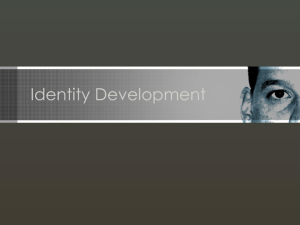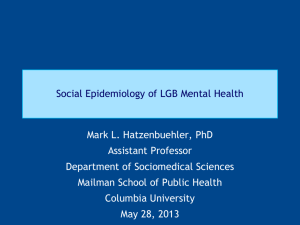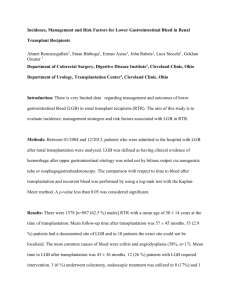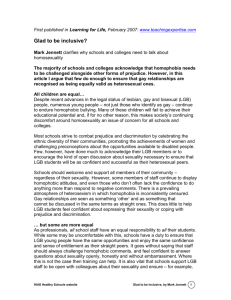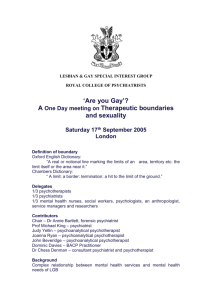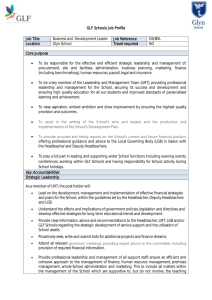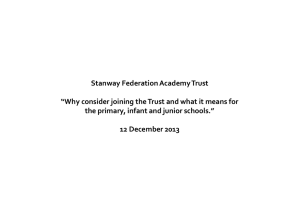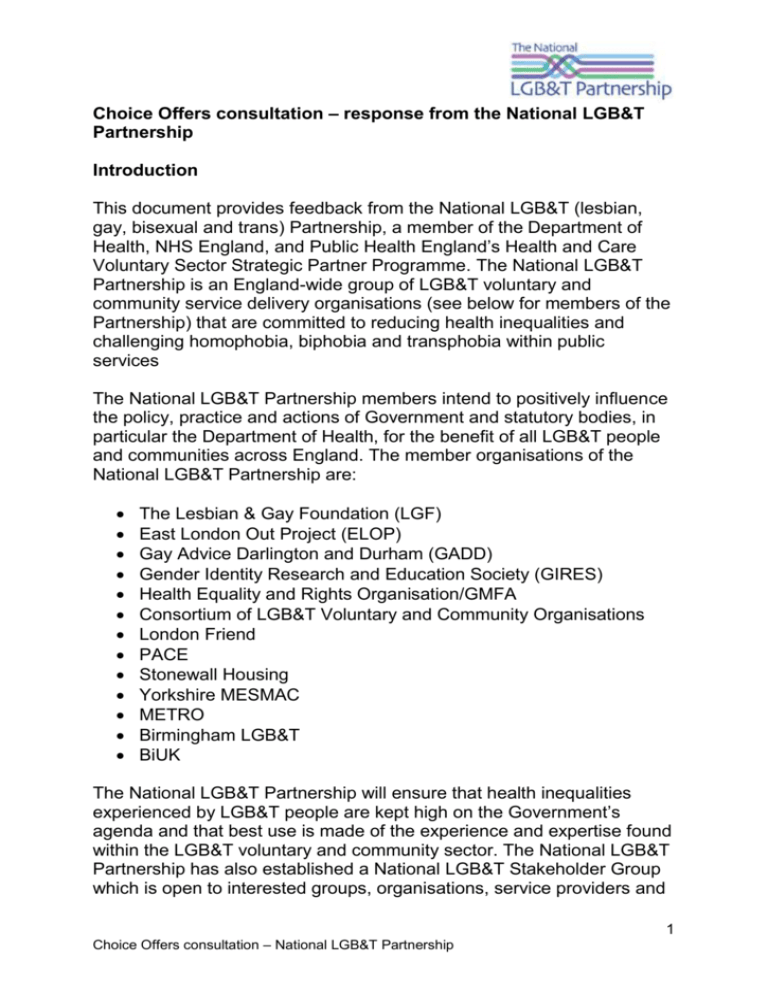
Choice Offers consultation – response from the National LGB&T
Partnership
Introduction
This document provides feedback from the National LGB&T (lesbian,
gay, bisexual and trans) Partnership, a member of the Department of
Health, NHS England, and Public Health England’s Health and Care
Voluntary Sector Strategic Partner Programme. The National LGB&T
Partnership is an England-wide group of LGB&T voluntary and
community service delivery organisations (see below for members of the
Partnership) that are committed to reducing health inequalities and
challenging homophobia, biphobia and transphobia within public
services
The National LGB&T Partnership members intend to positively influence
the policy, practice and actions of Government and statutory bodies, in
particular the Department of Health, for the benefit of all LGB&T people
and communities across England. The member organisations of the
National LGB&T Partnership are:
The Lesbian & Gay Foundation (LGF)
East London Out Project (ELOP)
Gay Advice Darlington and Durham (GADD)
Gender Identity Research and Education Society (GIRES)
Health Equality and Rights Organisation/GMFA
Consortium of LGB&T Voluntary and Community Organisations
London Friend
PACE
Stonewall Housing
Yorkshire MESMAC
METRO
Birmingham LGB&T
BiUK
The National LGB&T Partnership will ensure that health inequalities
experienced by LGB&T people are kept high on the Government’s
agenda and that best use is made of the experience and expertise found
within the LGB&T voluntary and community sector. The National LGB&T
Partnership has also established a National LGB&T Stakeholder Group
which is open to interested groups, organisations, service providers and
1
Choice Offers consultation – National LGB&T Partnership
individuals, giving a direct voice to the LGB&T sector. For more
information, see www.lgf.org.uk/for-professionals/the-national-LGB&Tpartnership.
Consultation response
Question 1: What kinds of choices should people be able to make
at the end of their life? Please list them in priority order and
describe what would need to be in place for them to be achieved.
Priority 1
Lesbian, gay, bisexual and trans (LGB&T) people should be able to
make choices about their care with full knowledge about whether the
providers of that care understand the specific needs of LGB&T people
and are able to meet those needs. There is clear evidence of
inconsistency in quality and appropriateness of the care received by
LGB&T people in end of life care (EOLC) services in relation to their
sexual orientation (see below). There are good examples of care which
acknowledges people’s identity and relationships, but unfortunately
others experience discrimination, for example, care staff ignoring samesex partners or not recognising families of choice; not using preferred
names of trans people; refusing services offered to heterosexual and
non-trans people; and not knowing or not giving appropriate information
about dealing with aspects of care related to sexual orientation, sexuality
and sexual functioning.
Evidence suggests that knowledge of older LGB people’s particular care
needs is low across services, with less than 10% of care homes and
domiciliary care providers having carried out specific work around
equality for LGB people and even fewer (less than 1%) having done any
specific work around sexual orientation and assessment or care
planning.1 Sexual orientation monitoring of healthcare service users is
not common or consistent. Furthermore, studies have shown that
healthcare practitioners are likely to avoid raising issues of sexuality with
older service users.2
For their part, almost half of older LGB people say they wouldn’t feel
comfortable being out to care home staff; one in three wouldn’t be
Ward, R, et al. Don’t look back? Improving health and social care service delivery for older LGB
users, Equality and Human Rights Commission, UK, 2010
2 Ward, R, et al. Don’t look back? Improving health and social care service delivery for older LGB
users, Equality and Human Rights Commission, UK, 2010
1
2
Choice Offers consultation – National LGB&T Partnership
comfortable being out to hospital staff, a paid carer, social workers, or to
their housing service provider; and one in five wouldn’t feel comfortable
disclosing their sexual orientation to their GP.3 Older LGB people are
also less likely than heterosexual people to feel confident that social
care and support services would be able to understand and meet their
needs.4
While recognising that not everybody experiencing end of life care will
be in an older age group, it is an issue that will affect many older LGB
people. Research on LGB people’s experiences of end of life care is
limited, and many studies focus on men living with HIV/AIDS.5 As
demonstrated by this report lesbian and bisexual women may be more
susceptible to certain life-threatening conditions whose prevalence
increases with age, for example breast cancer. They are also less likely
to have help and support from family members and may therefore be
more likely to need end of life care. Yet there is evidence that barriers
exist to accessing these services.
Many of these barriers are similar to those around health and social care
access. For example, discrimination and heteronormativity (the
assumption that all people are heterosexual); a lack of LGB friendly
environments for care delivery; discomfort disclosing sexual orientation
to healthcare providers; and actual experience of discrimination and
abuse, as well as fears of such treatment (e.g. because of past negative
experiences) are major barriers for LGB people maintaining contact with
health care providers and seeking the health care they need in a timely
manner.6
There are however specific issues related to end of life care services.
One study found that nearly 80% of LGB people said that their
healthcare providers had never asked who should make medical
decisions if they were unable to do so themselves.7 Several studies have
3
Stonewall. Lesbian, gay and bisexual people in later life. Stonewall, UK, 2011
Stonewall. Lesbian, gay and bisexual people in later life. Stonewall, UK, 2011 and Ward, R, et al.
Don’t look back? Improving health and social care service delivery for older LGB users, Equality and
Human Rights Commission, UK, 2010
5 Cartwright, C, Hughes, M and Lienert, T, ‘End-of-life care for gay, lesbian, bisexual and transgender
people’, Culture, Health & Sexuality: An International Journal for Research, Intervention and Care,
14:5, pp. 537, USA, 2012.
6 Cartwright, C, Hughes, M and Lienert, T, ‘End-of-life care for gay, lesbian, bisexual and transgender
people’, Culture, Health & Sexuality: An International Journal for Research, Intervention and Care,
14:5, pp. 537, USA, 2012.
7 Stein, G et al., ‘Attitudes on End-of-Life Care and Advance Care Planning in the Lesbian and Gay
Community’, Journal of Palliative Medicine, 4:2, pp. 177, USA 2001.
4
3
Choice Offers consultation – National LGB&T Partnership
pointed to a lack of understanding among healthcare providers of the
role of same-sex partners, friends and those considered as family by
LGB patients receiving end of life care.8 For example, one study found
that more than half of LGB people had been barred from visiting their
hospitalised partners on at least one occasion.9 In some cases these
problems arise when LGB people are not out to their family and
healthcare providers automatically assume that decision-making should
be delegated to the family members, rather than the same-sex partner.
This may occur because the couple may not have made their
relationship clear to healthcare providers due to fear of discrimination.10
Social care is behind other health services in looking at LGB&T issues.
The recent Equalities and Human Rights Commission report into
homecare stated: “Older lesbian, gay, bisexual and trans people quite
often, we have found, face harassment or misunderstanding … or
ignorance of their needs in [care] services so they often have to go back
into the closet for fear of the reaction that they might get from care
providers”.11
What would need to be in place for this to be achieved?
Providers of care services have a duty under the Equality Act 2010 to
meet the needs of LGB&T service users. In order to achieve this,
providers must monitor the sexual orientation and gender identity of
service users, in order to understand needs and experiences of service
users. The National LGB&T Partnership recommends best practice
guidance on monitoring which can be accessed here: www.lgf.org./som
and www.gires.org.uk/assets/Workplace/Monitoring.pdf.
Providers must also ensure that staff receive training on LGB&T issues
including inclusive communication. Policies and promotional materials
must use LGB&T inclusive language and imagery. Once these steps
have been achieved, providers should also promote that their services
Cartwright, C, Hughes, M and Lienert, T, ‘End-of-life care for gay, lesbian, bisexual and transgender
people’, Culture, Health & Sexuality: An International Journalfor Research, Intervention and Care,
14:5, pp. 539-540, USA, 2012.
9 Buckey J W & Browning, C N, ‘Factors Affecting the LGBT Population When Choosing a Surrogate
Decision Maker’, Journal of Social Service Research, 39:2, p.241, USA, 2013.
10 Cartwright, C, Hughes, M and Lienert, T, ‘End-of-life care for gay, lesbian, bisexual and transgender
people’, Culture, Health & Sexuality: An International Journal for Research, Intervention and Care,
14:5, p. 539, USA, 2012 and Smolinski, K M & Colón, Y, ‘Silent Voices and Invisible Walls: Exploring
End of Life Care with Lesbians and Gay Men’, Journal of Psychosocial Oncology, 24:1, pp.51-64,
USA, 2006
11 Ward, R, et al. Don’t look back? Improving health and social care service delivery for older LGB
users, Equality and Human Rights Commission, UK, 2010
8
4
Choice Offers consultation – National LGB&T Partnership
are LGB&T friendly (for example by displaying a rainbow flag and
equality policies prominently) to encourage LGB&T people to feel
comfortable and come out to care staff.
Ultimately, choice needs to be considered in terms of options that are
appropriate for the whole person; choices shouldn’t be based on
assumptions of what an individual needs or wants, but on the
characteristics of the person (such as sexual orientation and gender
identity) which can impact on their needs. Services must create an
environment in which people can be comfortable to be open and
disclose information about these characteristics if they choose to.
Treating everybody the same is not responding to people’s actual needs,
and an ethos of person-centred care should do the latter.
Priority 2
LGB&T people should be able to make informed choices about the
options open to them regarding EOLC and preparation for wills and
funerals. There is currently a lack of understanding (both among
individuals and services) of the legislation relating to same-sex couples
(e.g. marriage, civil partnership, cohabitation, and the stance of
churches and other religious organisations towards same-sex couples).
This leads to a risk of poorly-informed conversations about available
options taking place between LGB&T people themselves and with
service providers. Choice is therefore restricted, as LGB&T may be
choosing from a more limited range of options.
In some cases, an LGB&T person may have a clear idea of what they
want in relation to EOLC, a will and funeral, but not have communicated
this to family. Many LGB&T people are not ‘out’ or open about their
sexual orientation or gender identity in all parts of their lives, which can
mean that family can be unsure what choices their loved one would want
to make about EOLC, a will (if one has not been written) or funeral
arrangements. If services assume that family members are best placed
to make decisions about care without learning more about the person’s
circumstances or consulting a family of choice (e.g. friends and partners
or ex-partners) there is a risk that decisions will be made counter to the
person’s preferences because of assumptions about who should or can
make decisions.
What would need to be in place for this to be achieved?
Firstly, care providers must make sure that staff are up-to-date on
legislation relating to same-sex couples and how it relates to the
5
Choice Offers consultation – National LGB&T Partnership
services they provide. Awareness raising campaigns aimed at the
LGB&T community could inform individuals of what options are available
to them regarding EOLC. LGB&T voluntary and community
organisations, such as The National LGB&T Partnership, which
represents 13 LGB&T voluntary and community sector organisations,
are willing to work with others across the care sector to achieve this. For
example, the National LGB&T Partnership is part of the Dying Matters
coalition which aims to change public knowledge, attitudes and
behaviours towards dying, death and bereavement and is actively
encouraging LGB&T people to take practical steps towards making their
end of life wishes known. Ultimately, sectors need to work together to
enable better choice and enable people to access it.
The NCPC’s own publication with the Consortium of Lesbian, Gay,
Bisexual and Transgendered Voluntary and Community Organisations,
Open to All? Meeting the needs of lesbian, gay, bisexual and trans
people nearing the end of life and the NHS End of Life Care
Programme’s The route to success in end of life care – achieving quality
for lesbian, gay, bisexual and transgender people both set out evidencebased recommendations and a stepped pathway for care providers and
individuals
(file:///C:/Users/heather.williams/Downloads/eolc_lgbt_route_to_success
_web.pdf. Providers should be encouraged to embed these
recommended actions in service provision.
Priority 3
Monitoring of service user sexual orientation and gender identity is not
comprehensive or consistent across the care sector, meaning that
LGB&T people’s needs are not often acknowledged or met within care
services. However, care professionals coordinating a patient's care need
to know all relevant information about that person, so full implementation
of sexual orientation and gender identity monitoring across the
healthcare system is vital. Understanding identity is key to delivering
services, so staff should receive training on LGB&T issues and should
be aware of LGB&T groups that may be able to offer support and
assistance in helping the patient to manage their own care, e.g. to
advocate for the person if they want to make a complaint about poor
treatment or neglect if the provider fails to understand issues that
concern a person’s sexual orientation and gender identity.
What would need to be in place for this to be achieved?
6
Choice Offers consultation – National LGB&T Partnership
See action recommended under Priority 1 (re. implantation of service
user monitoring and staff training).
Priority 4
It can be very difficult for LGB&T people to access appropriate support
around EOLC including bereavement support for partners. One of our
member organisation’s recently supported a gay man whose partner had
recently died. As he was a military veteran, the man had contacted the
Royal British Legion for support, but found that their bereavement
services were not set up to meet LGB&T people’s needs; all other
members of a peer group were heterosexual, and heterosexuality was
assumed as the norm. In another case, we have supported a gay man
who wanted to find a gay-friendly vicar to discuss his bereavement and
arrange a gay-friendly Christian funeral for his partner, but he was
unsure how to find this and nervous to approach a church that might not
understand his request.
What would need to be in place for this to be achieved?
Organisations offering support to partners during EOLC and following
the death of a partner must be inclusive of LGB&T people accessing
these services. LGB&T specific services are keen to work with national
organisations to promote their services and promote LGB&T inclusivity.
Question 2: Do you have examples of where people have been able
to make choices about the care and support they receive at the end
their life? Please share your examples below:
[Please share any examples you have]
Question 3: How would we know if a ‘national choice offer’
improved people’s experience of care at the end of life? For
example, how we might be able to measure and evaluate the impact
on the quality of care and support received.
Any measurement and evaluation of the proposed offer must include
monitoring of service user sexual orientation and gender identity in order
to understand the experiences of LGB&T people. The National LGB&T
Partnership is keen to work with the NCPC in order to gather case
studies from LGB&T people about their experiences of accessing EOLC
following introduction of a national choice offer.
7
Choice Offers consultation – National LGB&T Partnership

